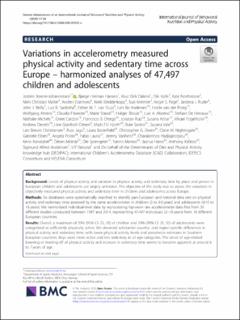| dc.contributor.author | Steene-Johannessen, Jostein | |
| dc.contributor.author | Hansen, Bjørge Herman | |
| dc.contributor.author | Dalene, Knut Eirik | |
| dc.contributor.author | Kolle, Elin | |
| dc.contributor.author | Northstone, Kate | |
| dc.contributor.author | Møller, Niels Christian | |
| dc.contributor.author | Grøntved, Anders | |
| dc.contributor.author | Wedderkopp, Niels | |
| dc.contributor.author | Kriemler, Susi | |
| dc.contributor.author | Page, Angie S. | |
| dc.contributor.author | Puder, Jardena J. | |
| dc.contributor.author | Reilly, John J. | |
| dc.contributor.author | Sardinha, Luís B. | |
| dc.contributor.author | van Sluijs, Esther M.F. | |
| dc.contributor.author | Andersen, Lars Bo | |
| dc.contributor.author | van der Ploeg, Hidde P. | |
| dc.contributor.author | Ahrens, Wolfgang | |
| dc.contributor.author | Flexeder, Claudia | |
| dc.contributor.author | Standl, Marie | |
| dc.contributor.author | Shculz, Holger | |
| dc.contributor.author | Moreno, Luis A. | |
| dc.contributor.author | De Henauw, Stefaan | |
| dc.contributor.author | Michels, Nathalie | |
| dc.contributor.author | Cardon, Greet | |
| dc.contributor.author | Ortega, Francisco B. | |
| dc.contributor.author | Ruiz, Jonatan | |
| dc.contributor.author | Aznar, Susana | |
| dc.contributor.author | Fogelholm, Mikael | |
| dc.contributor.author | Decelis, Andrew | |
| dc.contributor.author | Olesen, Line Grønholt | |
| dc.contributor.author | Hjorth, Mads F. | |
| dc.contributor.author | Santos, Rute | |
| dc.contributor.author | Vale, Susana | |
| dc.contributor.author | Christiansen, Lars Breum | |
| dc.contributor.author | Jago, Russell | |
| dc.contributor.author | Basterfield, Laura | |
| dc.contributor.author | Owen, Christopher G. | |
| dc.contributor.author | Nightingale, Claire M. | |
| dc.contributor.author | Eiben, Gabriele | |
| dc.contributor.author | Polito, Angela | |
| dc.contributor.author | Lauria, Fabio | |
| dc.contributor.author | Vanhelst, Jeremy | |
| dc.contributor.author | Hadjigeorgiou, Charalambos | |
| dc.contributor.author | Konstabel, Kenn | |
| dc.contributor.author | Molnár, Dénes | |
| dc.contributor.author | Sprengeler, Ole | |
| dc.contributor.author | Manios, Yannis | |
| dc.contributor.author | Harro, Jaanus | |
| dc.contributor.author | Kafatos, Anthony | |
| dc.contributor.author | Anderssen, Sigmund Alfred | |
| dc.contributor.author | Ekelund, Ulf | |
| dc.date.accessioned | 2021-02-10T09:43:34Z | |
| dc.date.available | 2021-02-10T09:43:34Z | |
| dc.date.created | 2020-11-19T14:33:19Z | |
| dc.date.issued | 2020 | |
| dc.identifier.citation | International Journal of Behavioral Nutrition and Physical Activity. 2020, 17(2020), Artikkel 38. | en_US |
| dc.identifier.issn | 1479-5868 | |
| dc.identifier.uri | https://hdl.handle.net/11250/2727112 | |
| dc.description | This article is distributed under the terms of the Creative Commons Attribution 4.0 International License (http://creativecommons.org/licenses/by/4.0/), which permits unrestricted use, distribution, and reproduction in any medium, provided you give appropriate credit to the original author(s) and the source, provide a link to the Creative Commons license, and indicate if changes were made. The Creative Commons Public Domain Dedication waiver (http://creativecommons.org/publicdomain/zero/1.0/) applies to the data made available in this article, unless otherwise stated. | en_US |
| dc.description.abstract | Background: Levels of physical activity and variation in physical activity and sedentary time by place and person in European children and adolescents are largely unknown. The objective of the study was to assess the variations in objectively measured physical activity and sedentary time in children and adolescents across Europe. Methods: Six databases were systematically searched to identify pan-European and national data sets on physical activity and sedentary time assessed by the same accelerometer in children (2 to 9.9 years) and adolescents (≥10 to 18 years). We harmonized individual-level data by reprocessing hip-worn raw accelerometer data files from 30 different studies conducted between 1997 and 2014, representing 47,497 individuals (2–18 years) from 18 different European countries. Results: Overall, a maximum of 29% (95% CI: 25, 33) of children and 29% (95% CI: 25, 32) of adolescents were categorized as sufficiently physically active. We observed substantial country- and region-specific differences in physical activity and sedentary time, with lower physical activity levels and prevalence estimates in Southern European countries. Boys were more active and less sedentary in all age-categories. The onset of age-related lowering or leveling-off of physical activity and increase in sedentary time seems to become apparent at around 6 to 7 years of age. Conclusions: Two third of European children and adolescents are not sufficiently active. Our findings suggest substantial gender-, country- and region-specific differences in physical activity. These results should encourage policymakers, governments, and local and national stakeholders to take action to facilitate an increase in the physical activity levels of young people across Europe. | en_US |
| dc.language.iso | eng | en_US |
| dc.subject | accelerometry | en_US |
| dc.subject | adolescent | en_US |
| dc.subject | child | en_US |
| dc.subject | child, preschool | en_US |
| dc.subject | Europe / epidemiology | en_US |
| dc.subject | exercise / physiology | en_US |
| dc.subject | female | en_US |
| dc.subject | humans | en_US |
| dc.subject | male | en_US |
| dc.subject | sedentary behavior | en_US |
| dc.title | Variations in accelerometry measured physical activity and sedentary time across Europe: Harmonized analyses of 47,497 children and adolescents | en_US |
| dc.type | Peer reviewed | en_US |
| dc.type | Journal article | en_US |
| dc.description.version | publishedVersion | en_US |
| dc.rights.holder | © The Author(s). 2020. | en_US |
| dc.source.pagenumber | 14 | en_US |
| dc.source.volume | 17 | en_US |
| dc.source.journal | International Journal of Behavioral Nutrition and Physical Activity | en_US |
| dc.identifier.doi | 10.1186/s12966-020-00930-x | |
| dc.identifier.cristin | 1849950 | |
| dc.description.localcode | Institutt for idrettsmedisinske fag / Department of Sports Medicine | en_US |
| cristin.ispublished | true | |
| cristin.fulltext | original | |
| cristin.qualitycode | 2 | |
